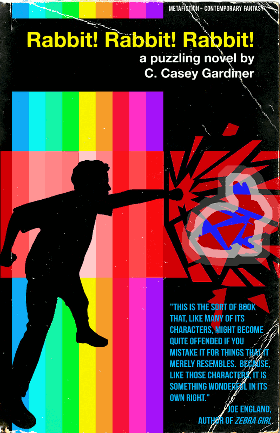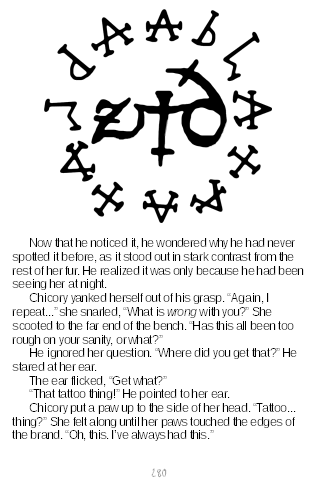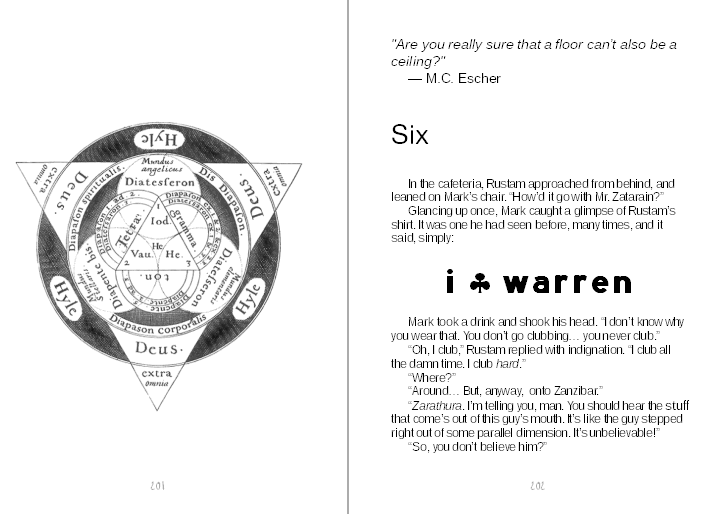Review: 'Rabbit! Rabbit! Rabbit! A Puzzling Novel', by C. Casey Gardiner
 This brick of a novel – 4¼” wide x 6 7/8” high x 2” thick – says on its cover that it is “metafiction”. That is apparently a synonym for bizarre. Gardiner has made it as bizarre as he could. For starters, the cover (I assume that Gardiner did it himself) appears to be from a very shabby, used copy, with several crease lines. But they are drawn into the new cover art; they are part of its design. The colophon says that this book is “written, designed, and illustrated by C. Casey Gardiner”, but his idea of illustrations are the graphics that appear frequently, rather than pictures.
This brick of a novel – 4¼” wide x 6 7/8” high x 2” thick – says on its cover that it is “metafiction”. That is apparently a synonym for bizarre. Gardiner has made it as bizarre as he could. For starters, the cover (I assume that Gardiner did it himself) appears to be from a very shabby, used copy, with several crease lines. But they are drawn into the new cover art; they are part of its design. The colophon says that this book is “written, designed, and illustrated by C. Casey Gardiner”, but his idea of illustrations are the graphics that appear frequently, rather than pictures.
This novel was successfully funded on Kickstarter during August-October 2012. Gardiner says, “There are many pictures, riddles, poems, songs and puzzles in its pages,” among more surrealistic statements such as, “It is not ergodic literature, nor is it transgressive.” (This is not the first printing; it is the ?st printing.)
The bottom line: will you enjoy Rabbit! Rabbit! Rabbit!? Yes. It is very well written, and bizarre in a good way, although you will have to work at getting it. Gardiner deliberately does not make it easy.
Detroit, MI, Blue Rabbit Fictions, July 2013, paperback $20 (752 [+ 22] pgs.). Illustrated by the author.
Mark Volhovsky is a “disenchanted teenager” supporting himself as a freelance demonologist in ramshackle Warren, Michigan. Hey, it’s a job, and he needs one as he goes about looking for his invisible blue rabbit friend.
But, then again, no one had ever said being a demonologist would be easy. In the right circles it sounded impressive, but he was a cut-rate demonologist, a hack exorcist. He stole his holy water from churches when the priests weren’t looking. He researched his techniques from grimoires bought at second-hand stores and rummage sales, and, of course, there was also the internet. He advertised in online forums, and for the time being, it paid the rent. (p. 5)
The problem is, Mark finds the demons but he doesn't find his rabbit friend.
Cut to a really long flashback to when Mark first met Chicory. He was six years old, the fatherless son of an immigrant Russian mother, and he badly needed a friend.
‘Hey!’ he said, ‘Don’t cry. What’s wrong?’
The little girl sniffed and lifted her head, and it was then that Mark saw she wasn’t a little girl at all, but a little blue rabbit. Mark was surprised, but he wasn’t startled. In his favorite stories, animals almost always talked, and at this point in his life, Mark expected all the animals in the world really could talk, but they just didn’t feel like there was anything particularly important to say.
The rabbit wiped her teary eyes with a blue paw. ‘Oh,’ she sniffed, ‘I just don’t know what to do. I don’t know where I am.’ (p. 13)
Mark and Chicory become inseparable friends. He learns that she is invisible to anyone but him, but this seems normal to him for a talking blue rabbit. An invisible magic friend seems normal to the adults around him, too – until he grows up.
[Mark’s mother and her boyfriend.] ‘It’s not normal, Anna.’
‘Oh, you don’t know that.’ She looked him steadily in the eyes. ‘There’s a lot of kids with imaginary friends out there.’
‘Maybe when they’re like three or something. Mark’s not that young! I mean, seriously. Having an imaginary friend at school is, like, completely alienating. He’s just begging to get beat up.’
[…]
Nigel crossed his arms. ‘Chicory creeps me out.’
She snickered, and little crumbs blew from her lips.
He shook his head. ‘I know it shouldn’t. But, when he talks now, it’s like he’s talking for both of them. Look at him out there.’ He pointed out the kitchen window at the fir tree. Outside, Mark was laughing in the general direction of a potted plant. ‘He’s just been sitting and talking, for hours … hours, Anna! And he’s just going to keep talking for hours.’ (pgs. 17-18)
 Nigel finally talks Anna into having Mark examined by a developmental psychologist.
Nigel finally talks Anna into having Mark examined by a developmental psychologist.
Of course Chicory goes along.
While Mark was answering questions, Chicory busied herself by going around the room and looking for anything suspicious – or, at least, anything to help ground her own suspicions in reality. As he talked, Mark could see her examining the titles of the books, looking at all the papers on the desk, and checking the plants for hidden video cameras.
She was very thorough in her search, and investigated every piece of furniture. At one point, Chicory climbed on top of the doctor’s chair to get a closer look at the top shelf of her library, but her foot slipped on the upholstery and she landed upside-down on her air-raid helmet, hitting the floor with a bump.
‘Shoot,’ said Chicory.
‘Shoot’, Mark said suddenly.’ (p. 31)
Mark’s favorite subject in school (with Chicory’s approval) is local (Michigan) history, especially the Native American folklore. An Ojibwe folk-tale of Nanabozho, the rabbit-god trickster, gets twelve pages in a different typeface.
Nigel, drunk, finally decides to force Mark to grow up. Chicory comes out of the shadows and almost kills Nigel. Mark, horrified, chooses a “normal” family life without Chicory. She leaves.
Years pass. Mark becomes a normal high school student. He learns to hang out with the boys and to smoke, and he gets a girl friend. And something invisible is stalking them.
[Mark and Jennifer are returning home late at night, alone, after a date.] Jennifer unlocked the car and they both slid inside, closing the doors. Jennifer started the engine. ‘We’ll let it run for a minute,’ she explained, 'just to let it warm up toas-tay.’ Her grin faded away as she looked past him. ‘Jesus, where’d he come from?’
Mark’s perception was bound to a certainty that whatever had been rushing at them a few moments earlier was here. He could feel the thing behind him. He knew it was behind him, outside the car, and that it lay in the exact direction in which Jennifer was looking. She seemed uneasy, but, he noted, she was not nearly as upset as he felt she should be.
Mark didn’t want to turn around to face it. His instincts were yelling at him to not turn around, to run, even though he was seated. He had hesitated too long. With all of his willpower, Mark forced himself to turn around, to help Jennifer. Taking a deep breath, he faced the thing at the window. (pgs. 113-114)
Yarst, this is turning into a long review. Up to now there has been very little anthropomorphism except for the blue rabbit girl. But Mark, who has been having feelings of something wrong stalking him, begins to have nightmares:
Her face was that of a hyper-intelligent short-haired canine, though less like that of a domesticated dog than a feral fox. Her body resembled some spotted wildcat like an ocelot or a jaguar, with the notable exception of two darkly feathered wings resting elegantly upon her back. The harpy stretched and folded her front paws, left over right, in a relaxed fashion. Mark was mostly comfortable with this, but then she spoke.
[…]
‘Well, then, allow me to explain the circumstances,’ the creature continued. ‘You must by now certainly be aware of the forces that are gathering within your city, even if you know not what they are. There are sides being chosen and lines being drawn. This is something that must not happen – not now. It is neither the time nor the place for such things. Of course, it may yet come to pass in the far future,’ she shook her muzzle in a disdainful manner, ‘but not for a long time to come.’
‘The powers are restless.’ She stretched her paws lazily, exposing ten delicately curved claws. ‘They have waited for aeons. Indeed, we have waited for aeons … but the world now belongs to the race of men, and there’s nothing left for us to do but watch and bide our time, and wait until the stars are right once again …’
Mark could only mutter, ‘Why are you telling me this stuff?’ (pgs 120-121)
To cut to the chase, assuming that Mark can believe the harpy who is a consummate liar, he is one of the few who can sense the supernatural battle of Good and Evil and intervene in it. That is why he drops out of high school and becomes a teenage demonologist. But he feels cut off and alone and not sure that he is fighting for the right side. He could really, REALLY use his old partnership with Chicory – if he can find her.
And he does. On page 127. So why is he looking for her again on page 6? (Remember, we’re still in the flashback.)

What Rabbit! Rabbit! Rabbit! A Puzzling Novel reminds me the most of is the Illuminatus! trilogy by Robert Shea & Robert Anton Wilson (all 1975; in one volume 1984). There is the revelation that we are all being controlled and fought over by vast conspiracies (not just one, but several); there are cryptic centuries-old symbols like the Eye of Providence; there is even a rabbit! (If Bugs Bunny is a fnord, then what is Chicory?) There are the other main characters in the novel; Rustam Bulsara, the high-school role-playing gamer, and Zarathura, the wise old wizard. (What is an epic fantasy without a Gandalf?) Mark, Chicory, Rusty, and Zarathura are fighting for a world that does not know it.
Yes, I think that you’ll like it. Even if there are not many anthropomorphic characters in it, you will remember Chicory.
The publication information indicates that Rabbit! Rabbit! Rabbit! is available in hardcover, paperback, and e-book editions, though this paperback is the only one that I can find any listing for. [See more sample pages and cover designs.]
About the author
Fred Patten — read stories — contact (login required)a retired former librarian from North Hollywood, California, interested in general anthropomorphics
Comments
Post new comment